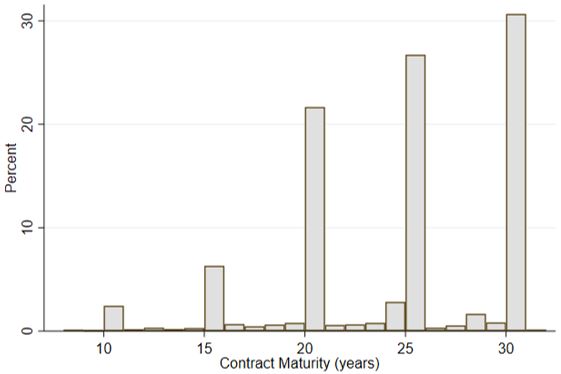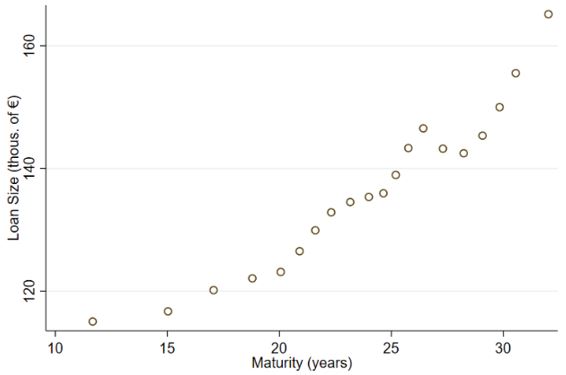

The opinions expressed in this paper are those of the authors and do not necessarily reflect the views of the ECB or the Eurosystem.
Using administrative data on mortgages issued in Italy between 2018 and 2019, this paper estimates loan demand elasticities to maturity and interest rate. We find that households are responsive to both contract terms: a 1% decrease in interest rate increases the average loan size by 0.22% whereas a 1% increase in maturity increases loan demand by 0.30%. This evidence suggests that credit constraints are relevant in this market. Things change substantially when moving along the distribution of contract maturities: short-term borrowers are unresponsive to their contract length while maturity elasticities are higher for long-term borrowers.
Households rely on credit markets to purchase goods that would not be affordable to them otherwise. Classic examples are durable goods like housing and cars which are typically financed via mortgages and auto loans, respectively. These latter are complex financial contracts where price and non-price dimensions interact together in determining borrowers’ total cost of credit. In this paper we join a recent literature that studies how credit demand responds to both price and non-price dimensions.
In Ferrari and Loseto (2023), we use credit register data on mortgages issued in Italy between 2018 and 2019 and start by documenting two important empirical facts: even for loan of the same size, there is substantial heterogeneity in the duration of realized mortgages (Figure 1) and a strong and positive correlation between the amount and maturity of the loan which indicates the possibility of credit demand being significantly upward sloping in the offered maturity (Figure 2). If this were the case, when offered a longer maturity borrowers would increase their debt balance and presumably increase current consumption, consistent with the presence of binding liquidity constraints.
Figure 1: More than 50% of mortgages have a maturity above 25 years

Figure 2: A longer maturity of mortgages is associated with a higher take-up

To test this intuition, we exploit the observed variation in contract maturities to estimate the loan demand elasticity to maturity separately from the loan demand elasticity to interest rates.
The basic identification challenge is that realized contract terms and loan demand are jointly endogenous. To isolate exogenous variation in the realized interest rates and maturities we complement our administrative dataset with data on mortgage offers posted by lenders on the main Italian mortgage online platform MutuiOnline.it.1 These offers are collected by submitting fictitious applications to the online platform and then recording the mortgage terms each lender is willing to offer to each possible combination of characteristics. Under the institutional agreement in which lenders and the online platform operate, conditional on the accuracy of the information provided by the applicant, the online offers are binding. This implies that posted offers are realistic and that the information an applicant is required to submit through the platform is enough for lenders to plausibly price a mortgage.
For each realized contract in our administrative dataset, we match an offered contract from our data on online offers. This allows us to instrument the realized interest rate and maturity with the corresponding terms of the matched offered contract. The main identifying assumption is that variation in online offers reflects changes in lenders’ supply policies that are excluded from loan demand.
Overall, we find that the average borrower response to an exogenous change in maturity is slightly stronger than its response to an exogenous change in interest rate. Holding everything else constant, a 1% increase in contract maturity increases credit demand by 0.30% whereas 1% decrease in interest rate increases demand by 0.22%. We further show that this high sensitivity to maturity is entirely driven by long-term borrowers. Our estimates suggests that short-term borrowers (i.e., contracts with maturities below 15 years) are unresponsive to changes in maturity while for long-term borrowers (i.e., contracts with maturities above 15 years) the maturity elasticity is larger than for the average borrower.
To interpret our estimates, we develop a simple life-cycle model with long-term instalment debt. In the first period, to increase current consumption households have access to a non-callable long-term debt contract with given rate and customizable duration whose principal and interests are repaid periodically in equal instalments over the life of the contract. The maximum loan size is bounded by a debt-to-income constraint ensuring that periodic payments can be covered by labour income only, whereas the contract length is bounded by the maximum available maturity.
In our simple model loan demand for constrained borrowers slopes upward in the maximum available maturity: longer contracts allow constrained borrowers to increase the size of their loan and in turn increase current consumption while maintaining the same debt-to-income ratio. On the other hand, unconstrained households that issue a positive amount of debt are unresponsive to their contract duration. % when offered an additional period to repay their loan unconstrained borrowers trade-off the benefits from lower payments with the cost of paying interests for an additional period. Thus, our model suggests that maturity elasticities can be used to test for the presence of liquidity constraints.
Altogether, the contribution of this paper is twofold. First, we quantify the maturity elasticity of loan demand for the case of mortgages which, to the best of our knowledge, is still unexplored.
Second, we exploit maturity elasticities to assess the importance of credit constraints in mortgage markets. Our baseline estimates suggest that binding credit constraints might be important in our setting. This evidence is further confirmed when we look at maturity elasticities separately for short- and long-term borrowers. We expect the former to be on average wealthier and less credit constrained, as short-term loans generally require higher payments. Our estimates corroborate this intuition: short-term borrowers are unresponsive to changes in their contract duration while long-term borrowers are more responsive to changes in maturity than the average borrower.
Turning to policy, our findings suggest that interventions targeting the supply of maturity could have a significant impact on credit demand. Furthermore, according to our estimates, these interventions will mostly affect credit constrained borrowers without distorting credit demand too much for unconstrained borrowers. Thus, compared to interest rate policies, maturity policies might be better suited for interventions that aim at affecting constrained borrowers and stimulating demand through credit accessibility.
Ferrari, A., and Loseto, M. (2023): “Liquidity constraints and demand for maturity the case of mortgages,” Working Paper Series N. 2859, European Central Bank.
Through the MutuiOnline.it platform potential borrowers can search, apply for and obtain a mortgage.